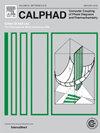Third generation Calphad: Thermodynamic assessment of the Ni-Ga system with physics-based models
IF 1.9
3区 材料科学
Q4 CHEMISTRY, PHYSICAL
Calphad-computer Coupling of Phase Diagrams and Thermochemistry
Pub Date : 2025-01-03
DOI:10.1016/j.calphad.2024.102797
引用次数: 0
Abstract
Prediction of phase equilibria, phase stability, and thermodynamic properties is crucial in materials science. The second generation Calphad (CALculation of PHAse Diagrams) method faces challenges at low temperatures and in magnetic property predictions. To address these issues, the third generation Calphad is being developed, but its application has been limited primarily to unary systems, i.e., pure elements. Here we show the successful optimization of the Ni-Ga system, characterized by low melting point of Ga, magnetism of Ni, and ordered phases, using third generation thermodynamic models. We calculated the magnetic properties of fcc and bcc solution phases using Density Functional Theory (DFT) and fitted them with an improved magnetic model. Ordered phases were described using a four-sublattice model. The resulting parameters accurately reproduce experimental phase diagrams and thermochemical properties. This study demonstrates the successful application of the Equal Entropy Criteria (EEC) in a system where the constituent elements show quite different melting points. This work establishes a foundation for applying third generation Calphad to complex alloy systems, potentially enhancing the accuracy of material design and thus accelerating new materials development.
第三代 Calphad:利用物理模型对镍镓系统进行热力学评估
相平衡、相稳定性和热力学性质的预测在材料科学中至关重要。第二代 Calphad(CALculation of PHAse Diagrams)方法在低温和磁性预测方面面临挑战。为了解决这些问题,第三代 Calphad 正在开发中,但其应用主要局限于单元系统,即纯元素。在这里,我们展示了利用第三代热力学模型对镍镓体系的成功优化,该体系的特点是镓的低熔点、镍的磁性和有序相。我们使用密度泛函理论(DFT)计算了 fcc 和 bcc 溶液相的磁性,并用改进的磁性模型对其进行了拟合。有序相使用四子晶格模型进行描述。所得参数准确地再现了实验相图和热化学性质。这项研究证明了等熵标准(EEC)在组成元素熔点迥异的体系中的成功应用。这项工作为将第三代 Calphad 应用于复杂合金体系奠定了基础,有可能提高材料设计的准确性,从而加速新材料的开发。
本文章由计算机程序翻译,如有差异,请以英文原文为准。
求助全文
约1分钟内获得全文
求助全文
来源期刊
CiteScore
4.00
自引率
16.70%
发文量
94
审稿时长
2.5 months
期刊介绍:
The design of industrial processes requires reliable thermodynamic data. CALPHAD (Computer Coupling of Phase Diagrams and Thermochemistry) aims to promote computational thermodynamics through development of models to represent thermodynamic properties for various phases which permit prediction of properties of multicomponent systems from those of binary and ternary subsystems, critical assessment of data and their incorporation into self-consistent databases, development of software to optimize and derive thermodynamic parameters and the development and use of databanks for calculations to improve understanding of various industrial and technological processes. This work is disseminated through the CALPHAD journal and its annual conference.

 求助内容:
求助内容: 应助结果提醒方式:
应助结果提醒方式:


